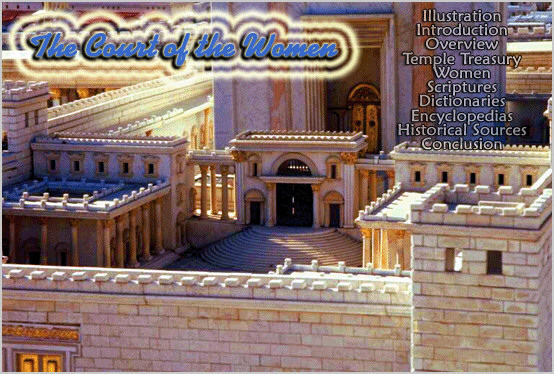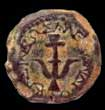The Court of the Women in the Temple
The Woodshed Court

The Chamber of Wood

The northeast court
was called "Woodshed." This is where the priests sorted the wood for sacrifices
that were destined for the altar. "At the north-east was the chamber of wood:
where the priests, defiled with any spot, searched the wood, whether it was
unclean by worms. And all wood in which a worm was found was not fit for the
altar."
--------------------------
Some
Commentary Notes:
Edersheim - The
Chambers. In each of the four corners of the Court of the Women were
chambers, or rather unroofed courts, each said to have been 60 feet long. In
that at the right hand (on the north-east), the priests who were unfit for other
than menial services on account of bodily blemishes, picked the worm-eaten
wood from that destined for the altar. In the court at the farther angle
(north-west) the purified lepers washed before presenting themselves to the
priests at the Gate of Nicanor. At the left (south-east) the Nazarites polled
their hair, and cooked their peace-offerings; while in a fourth court (at the
south-west) the oil and wine were kept for the drink-offerings. The musical
instruments used by the Levites were deposited in two rooms under the Court of
the Israelites, to which the access was from the Court of the Women. Of course
the western colonnade of this court was open. Thence fifteen easy steps led
through the so-called Gate of Nicanor into the Court of Israel. On these steps
the Levites were wont on the Feast of Tabernacles to sing the fifteen 'Psalms of
Degrees,' or ascent (Psalms 120 to 134), whence some have derived their name.
Here, or, rather, in the Gate of Nicanor, all that was ordered to be done
'before the Lord' took place. There the cleansed leper and the women coming for
purification presented themselves to the priests, and there also the 'water of
jealousy' was given to the suspected wife.
Read More
Lightfoot - Before which were the
treasuries placed, or thirteen chests, called by the Talmudists, Shopharoth; in which was put the money offered for the various
services of the Temple; and, according to that variety, the chests had various
titles written on them: whence the offerer might know into which to put his
offering, according to his quality. Upon one was inscribed, "The new shekels";
into which were cast the shekels of that year. Upon another, "The old shekels";
into which were gathered the shekels owing the last year. Upon another, "pigeons
and turtles." Upon another, "The burnt sacrifice." Upon another, "The wood."
Upon another, "Frankincense." Upon another, "Gold for the propitiation." And six
chests had written on them, "Voluntary sacrifice." "The length of the Women's
Court was a hundred thirty-five cubits, and the breadth a hundred thirty-five
cubits. And there were four chambers in the four corners of it, each forty
cubits, but not roofed." See Ezekiel 46:21,22. "At the south-east was the court
of the Nazarites: because there the Nazarites boiled their thank-offerings, and
cut their hair, and put it under the pot." "At the north-east was the chamber of
wood: where the priests, defiled with any spot, searched the wood, whether it
was unclean by worms. And all wood in which a worm was found was not fit for
the altar." "At the north-west was the chamber of the Leprous." "At the
south-west was the chamber of wine and oil." "On the highest sides", "was the smooth and plain Court of the
Women; but they bounded it round about with an inward gallery, that the women
might see from above, and the men from below, that they might not be mingled."
In this Court of the Women was celebrated the sacred and festival dance, in the
feast of Tabernacles, called the "Pouring out of Water": the ritual of which you
have in the place cited in the margin. "The Court of the Women was more sacred
than the Chel; because any, who had contracted such an unclearness that was to
be cleansed the same day, might not enter into it."

The Women's Court in the
Temple in Jerusalem

Mark 12:41-44 "Now Jesus sat opposite the treasury and saw how the people
put money into the treasury. And many who were rich put in much. Then one
poor widow came and threw in two mites, which make a quadrans. So He called
His disciples to Himself and said to them, "Assuredly, I say to you that
this poor widow has put in more than all those who have given to the
treasury; for they all put in out of their abundance, but she out of her
poverty put in all that she had, her whole livelihood."
The
Jerusalem Temple
 If you were to approach the Temple in
Jerusalem in the first century A.D. you would pass through the eastern gate
where Jesus made His triumphal entry. Then you would come to the Court of
the Gentiles which was a large court paved with stones of various colors. It
was open to all comers including the cattle-dealers and the money-changers
who desecrated the Temple. This court was also called the Outer Court, the
Lower Court, and the rabbi�s usually called it "the Mountain of the Lord�s
House." All around the Temple proper was a 9 foot high terrace with stairs
which was higher than the Court of the Gentiles. It was surrounded by a 5
foot high wall which was designed to keep out the gentiles. There was also
pillars in the wall at various distances (the Soreg) with inscriptions in
Latin, Greek, and Hebrew, warning all gentiles to come no further under
penalty of death.
If you were to approach the Temple in
Jerusalem in the first century A.D. you would pass through the eastern gate
where Jesus made His triumphal entry. Then you would come to the Court of
the Gentiles which was a large court paved with stones of various colors. It
was open to all comers including the cattle-dealers and the money-changers
who desecrated the Temple. This court was also called the Outer Court, the
Lower Court, and the rabbi�s usually called it "the Mountain of the Lord�s
House." All around the Temple proper was a 9 foot high terrace with stairs
which was higher than the Court of the Gentiles. It was surrounded by a 5
foot high wall which was designed to keep out the gentiles. There was also
pillars in the wall at various distances (the Soreg) with inscriptions in
Latin, Greek, and Hebrew, warning all gentiles to come no further under
penalty of death.
Going beyond the Court of the Gentiles and at the top of the terrace there
was a platform for about 15 feet and then there was another wall. On the
east side stood the magnificent 60 foot wide "Gate Beautiful" mentioned in
Acts 3:2,10. It was also referred to as the "Gate Susan" because it
contained a beautifully sculptured relief of the city of Susa. During the
time of the morning and evening sacrifices this great entrance was the place
of public worship.
Entering through the Susan Gate you would come to a large court called "the
Court of the Women" not because there were only women there but because
women could not go beyond it. There were smaller courts with columns in the
four corners of the court.
According to the Mishnah (Middoth 2,5) the Women's Court was was just over
200 feet square between bounding lines. Each court on the outside was 60
feet square.
In front of these columns were the eleven treasure chests of the Temple for
the voluntary offerings of money, and there were also two at the Gate of
Susan, for the half-shekel tax. Jesus was sitting �opposite the treasury'
when he saw the widow put into one of the containers the two copper coins
which were all that she had (Mark 12:41-44; Lk 21:1-2).
It was near these treasure chests that the man healed of his blindness came
up to Jesus in John 8:20 and worshipped Him.
Continuing eastward there was a magnificent circular staircase and the
Nicanor Gate. Entering through the gate there was a narrow hall filled with
beautiful cloistered columns called "Court of the Israelites" and it was
also through a wall and up a flight of stairs. The Court of the Israelites
surrounded the "Court of the Priests" which was where the altar of sacrifice
was. The women could only glance over a balcony from the Court of the Women
to see the ceremonies inside the Inner Court (According to Middoth).
Illustration
Introduction
Overview
Chel
Beautiful Gate
Nicanor Gate
Circular Steps
Levite Choirs
Oil of Yah Court
Nazarite Court
Leper's Chamber Court
Woodshed Court
Colonnades
Balconies
The Temple Treasury
Women
Scriptures
Dictionaries
Encyclopedias
Historical Sources
Heart Message
An Old
Woman - A Heart Message

Related Content